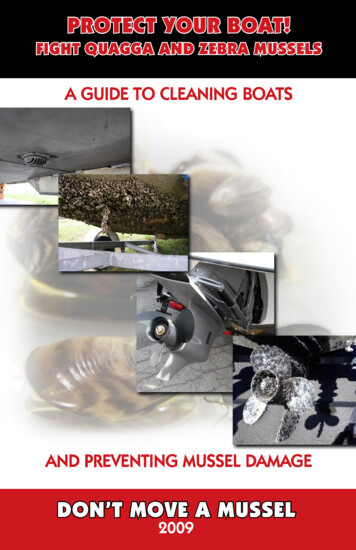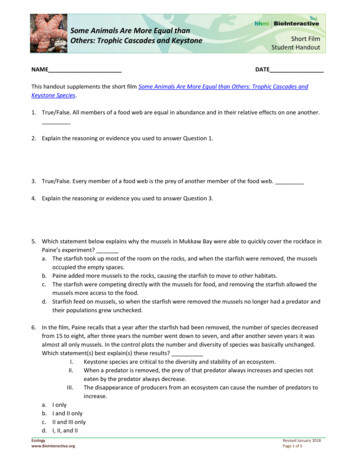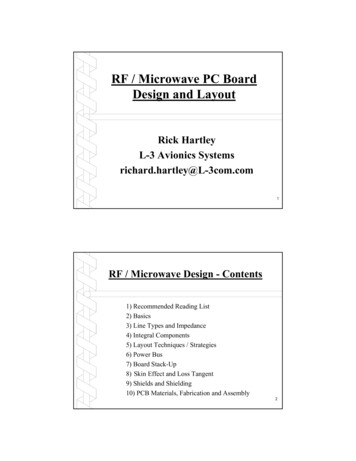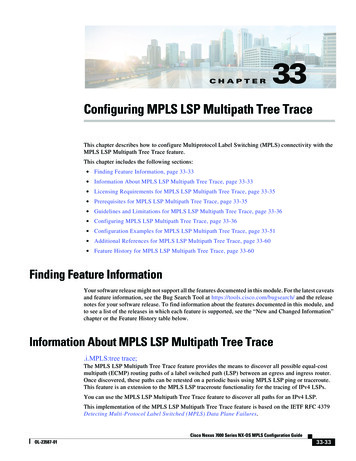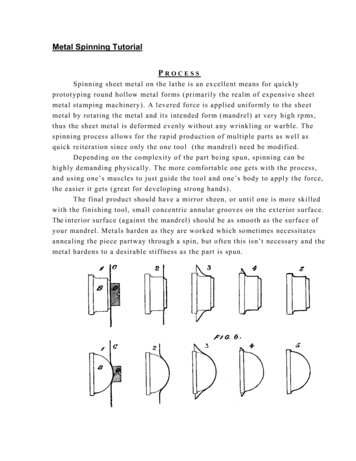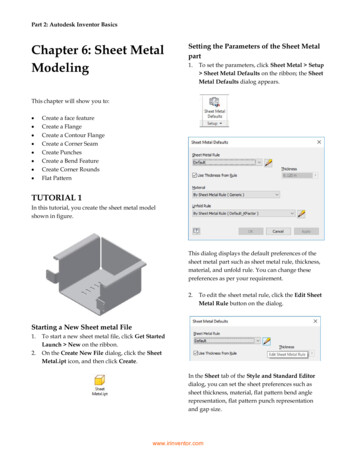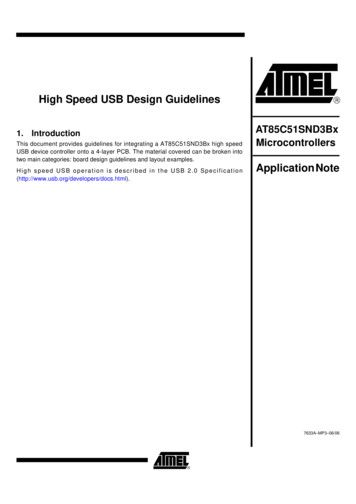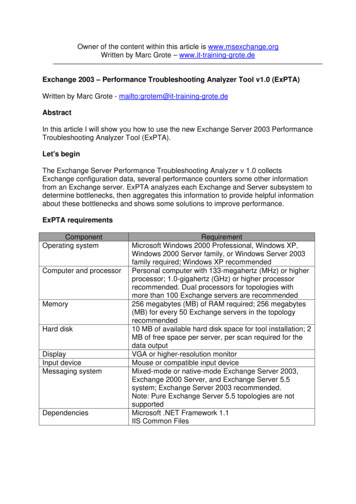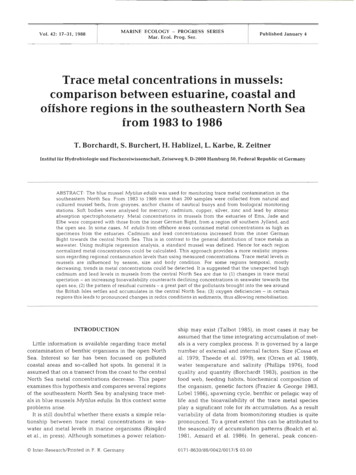
Transcription
Vol. 42: 17-31, 1988IMARINE ECOLOGY - PROGRESS SERIESMar. Ecol. Prog. Ser.lPublished January 4Trace metal concentrations in mussels:comparison between estuarine, coastal andoffshore regions in the southeastern North Seafrom 1983 to 1986T. Borchardt, S. Burchert, H. Hablizel, L. Karbe, R. ZeitnerInstitut fiir Hydrobiologie und Fischereiwissenschaft, Zeiseweg 9. D-2000Hamburg 50,Federal Republic of GermanyABSTRACT: The blue mussel Mytilus edulis was used for monitoring trace metal contamination in thesoutheastern North Sea From 1983 to 1986 more than 200 samples were collected from natural andcultured mussel beds, from groynes, anchor chains of nautical buoys and from biological monitoringstations. Soft bodies were analysed for mercury, cadmium, copper, silver, zinc and lead by atomicabsorption spectrophotometry. Metal concentrations in mussels from the estuaries of Ems, J a d e andElbe were compared with those from the inner German Bight, from a region off southern Jylland, andthe open sea. In some cases, M. eduljs from offshore areas contained metal concentrations as hlgh a sspecimens from the estuaries. Cadmium and lead concentrations increased from the inner GermanBight towards the central North Sea. This is in contrast to the general distribution of trace metals inseawater. Using multiple regression analysis, a standard mussel was defined. Hence for each regionnormalized metal concentrations could be calculated. This approach provides a more realistic impression regarding regional contamination levels than using measured concentrations. Trace metal levels inmussels are influenced by season, size and body condition. For some regions temporal, mostlydecreasing, trends in metal concentrations could b e detected. It is suggested that the unexpected highcadmium and lead levels In mussels from the central North Sea are due to (1) changes in trace metalspeciation - an increasing bioavailability counteracts declining concentrations in seawater towards theopen sea; (2) the pattern of res dualcurrents - a great part of the pollutants brought into the sea aroundthe British Isles settles and accumulates in the central North Sea; ( 3 ) oxygen deficiencies - in certainregions this leads to pronounced changes in redox conditions in sedirnents, thus allowing remobilisation.INTRODUCTIONLittle information is available regarding trace metalcontamination of benthic organisms in the open NorthSea. Interest so far has been focussed on pollutedcoastal areas and so-called hot spots. In general it isassumed that on a transect from the coast to the centralNorth Sea metal concentrations decrease. This paperexamines this hypothesis and compares several regionsof the southeastern North Sea by analysing trace metals in blue mussels Mytilus edulis. In this context someproblems arise.It is still doubtful whether there exists a simple relationship between trace metal concentrations in seawater and metal levels in marine organisms ( h i s g i r det al., in press). Although sometimes a power relation@ Inter-Research/Printed in F. R . Germanyship may exist (Talbot 1985), in most cases it may beassumed that the time integrating accumulation of metals is a very complex process. It is governed by a largenumber of external and internal factors. Size (Cossa etal. 1979, Theede et al. 1979), sex (Orren et al. 1980),water temperature and salinity (Phillips 1976), foodquality and quantlty (Borchardt 1983), position in thefood web, feeding habits, biochemical composition ofthe organism, genetic factors (Frazier & George 1983,Lobe1 1986),spawning cycle, benthic or pelagic way oflife and the bioavailability of the trace metal speciesplay a significant role for its accumulation. As a resultvariability of data from biomonitoring studies is quitepronounced. To a great extent this can be attributed tothe seasonality of accumulation patterns (Boalch et al.1981, Amiard et al. 1986). In general, peak concen-
18Mar. Ecol. Prog. Ser. 42: 17-31, 1988trations in mussels occur in late winter, and minimumvalues are found in autumn. The range of variation isabout 2- to 3-fold.To solve this problem it was proposed to investigatemetal contamination under standardized conditions,i.e. samples would be taken at the same time of theyear, a t the same depths, from similar substratum, andorganisms would b e of comparable size and age.This approach limits the ability to evaluate existingdata sets compiled under non-standard conditions.Moreover the investigator is restricted to collectingsamples only from a uniform environment. In realitythese conditions hardly apply, especially when largeareas must be examined.In thls study contamination of mussels from 6 different regions was investigated from 1983 to 1986. Theseregions comprise the estuaries of Ems, J a d e a n d ElbeRivers, the inner German Bight, a region off southernJylland and the open sea. The data set includesmussels from groynes, natural and cultured musselbeds, from anchor chains of nautical buoys and frombiomonitoring stations. Measurements in the 3estuaries cover different seasons, while samples fromoffshore regions were mainly collected in summer.Mussels from groynes were usually smaller andshowed a lower body condition index than those fromother sites. All this contributes to a strong inconsistencyof sampling conditions. Nevertheless these difficultiescannot b e avoided when comparing different regions.As a n alternative approach, a mathematical standardization of the samples was introduced, comparable tothe established method of relating chlorinated hydrocarbons to fat content. In earlier studies, trace metalconcentrations or body burdens respectively wererelated to shell weight (Fischer 1983), size and softbody dry weight (Cossa & Rondeau 1985), size and fatcontent (Green et al. in press) and to size and bodycondition (Borchardt et al. in press). In the presentpaper temporal trends also were considered, as theperiod analysed covered a n interval of 4 yr. After standardization the normalized metal concentrations ofmussels from the different regions may be compared.This provides a more realistic view of reg onalcontamination patterns than comparing the true, measuredconcentrations.MATERIAL AND METHODSThere are 2 basic principles in conductingbiomonitoring studies. Both the 'active' and 'passive'concept were realized in the present study. The activebiomonitoring approach is based on exposing wellcharacterized mussels under standardized conditionsover a defined tlme span. Normally 2 size classes wereused: 3 cm and 5 cm shell length. At start and endof the exposure period they were measured for shelllength, shell weight, soft body fresh and dry weight,total volume, shell volume and trace metal concentrations. This approach has the advantage that manyexternal conditions can b e controlled, and that musselscan be exposed wherever desired.Eighty large or 100 small individuals were placed ina net bag (mesh size 1 cm). Their origin was either amussel culture in Jade Bay or near Arendal (Norway).Norwegian mussels were classified as being 'low contaminated' and able to accumulate metals in the opensea. Eight bags were attached to a n underwaterp o l y u r e t h a n e foamhooka l u m i n i u m cone-rubberbuffer- rubberbuffer-centraltubedlurninlum ringcentraltubetop ofalurnlnlconerubber b u f f e rFig. 1 Aluminium underwater buoy (diameter 1 m, height1 m). Upper. side vlew; lower. top plan viewaluminium buoy (Fig. 1). Aluminium was chosenbecause it contains only negligible amounts of othertrace metals, and because of its low specific weight.The buoy was filled with a polyurethan foam protectingit against leakage and giving a buoyancy of 68 kp. Thecone shape reduces hydrodynamic resistance. Tworubber rings serve as buffers when the station isbrought out or taken in from the research vessel.Nearshore, this buoy was marked with orange plasticballs and secured by a usual fishery buoy (Fig. 2a). Themussels were suspended at a depth of about 4 m,
Borchardt et al.: Trace metal concentrations in musselsEGal r!mln l u m buoy7Fig. 2. Upper: Nearshore mussel watch stat on.Monitoringorganisms are recovered by divers. The station is marked byorange plastic balls. Lower: Offshore mussel watch station.For recovery of the monitoring organisms the unmarked station is found by DECCA-navigation; the exact positions ofground weights are knownvarying with the tides. The distance between themussel watch station and the fishery buoy was 50 m.Samples could easily be collected by research diverswithin a few minutes.Offshore, the station was suspended at a depth of10 m and was not marked. Only the position of the2 ground weights was known exactly by DECCA-navigation. The weights were connected by a 400 m cable.For recovery of the biomonitoring organisms the complete station and its anchorage (Fig. 2b) had to b eretrieved. This was accomplished by pulling a draganchor across the cable.The passive biomonitoring approach simply collectsmussels where they occur naturally. In the presentstudy samples were taken from groynes, mussel bedsand chains of nautical buoys. Samples from the anchorchains of buoys were taken by divers at 10 m depth toavoid the possible influence of metal-containing antifouling paints. If available, 30 to 50 individuals werecombined in one sample.Sampling sites (Fig. 3) were grouped into 6 regions. Itwas assumed that these water bodies were relativelyhomogenous as far as trace metals were concerned.They were termed Ems, Jade, Elbe regions, inner Ger-19man Bight, southern Jylland, and open sea. Part of thenon-estuarine, nearshore data was taken from Jensen(1985).After collection, mussel shells were roughly cleaned.Depending on temperature, mussels were maintainedin seawater for defaecation over a period of 1 or 2 d.Shells were then freed from epifauna, mainlyBalanus sp. Individual shell length was measured, a n dtotal volume was determined by water displacement ina measuring cylinder. Mussels were induced to opentheir shells by putting them into a microwave oven (450W) for about 2 min. Then they were drained on filteringpaper for 5 min, positioned on the edges of their shells.Soft bodies were separated from the shells usingtitanium-teflon-scapels. Shells were air dried for 1 wk,then shell weight w a s determined. Soft bodies wereplaced in Petri dishes. Wet weight was determinedbefore, a n d dry weight after, freeze-drying at -25 "Cand 0.05 Torr. Afterwards soft bodies were pulverizedby a n agat ball mill. An aliquot was pressure-digested(Tijlg-apparatus, stepwise to 200 OC, 65 O/O HN03).Metal concentrations were determined with agraphite furnace atomic absorption spectrophotometer(Perkin Elmer AAS 540 and AAS 2380, each coupled toa HGA 500 programmer) using a L'VOV-platform forhigher sensitivity, precision and reproducibility.From each sample 2 subsamples were analysed. Atthe start of each analytical series a standard additionwas carried out using a laboratory-internal Mytilusedulis standard, intercalibrated with NBS standardreference material 1577 (bovine liver). Subsequentsamples were analysed directly, since matrices of bluemussels from different sites were very similar.Mercury was determined by the cold vapour method(Perlun Elmer MAS 50).To detect temporal trends, metal concentrations (y)were correlated with date, transformed into a decimalform (X date*,,). Using the t-distribution trends weretested by p'by, \ z x 2 - l / n ( 2 ) -l( E )- b(X- l / n EX l/(1) n -2To determine seasonal influences the date was transformed by a sine function simulating average watertemperatures T The model predicts minimum watertemperatures of 2 C at the end of February and maximum temperatures of 18 "C at the e n d of August:T 10 [8sin ([date*,, - INT date,,,]360) 2101 (2)where INT dated,, integer form of the demical date.Regression analyses a n d statistical tests presupposeda normal distribution of the data used. This assumptionwas routinely checked by a range to standard deviationtest (R/S-test, Sachs 1979).
Mar Ecol. Prog. Ser. 42: 17-31, 198820RESULTSTemporal trendsDescription of data setsTo determine significant temporal trends, the datashould cover at least a 3 yr period and should be evenlydistributed in time. Of the 6 chosen regions, thesepresuppositions apply only to the data from the Ems,Jade and Elbe.A significant decrease ( p 0.05) from 1983 to 1985/86 was determined for mercury concentrations inmussels from the Ems (Fig. 4a, 0.36 0.16 mg kg-')and J a d e region (0.38 0.28 mg kg-'), and for cadmium in the Jade (2.0 1.5 mg kg-') and Elbe region(4.0 -, 2.1 mg kg-'). Copper levels decreased in theJade (9.8 6.8 mg kg-'), as did zinc levels in the Jade(143 - 125 mg kg-') and the Elbe area (167 104 mgkg-'). Only lead concentrations significantly increasedin the Jade estuary (1.7 -. 2.3 mg kg-'). Hence 7decreases in metal concentrations in Mytilus edulisoccurred, with only one increase.Fig. 3 gives the positions of sampling sites. Between1983 and 1986, 227 samples were taken at 50 differentstations. With a few exceptions, all of them were analysed for mercury, cadmium, copper, silver, zinc andlead. From 1362 metal measurements, 7 were excludedfrom evaluation: 5 copper values might have beenexceptionally enhanced due to a short term contamination of the respective estuaries, while 2 unusually highSeasonal influencesFig. 3. Sampling sites for Mytilus edulis in the south easternNorth Sea. (---) Transects for calculation of spatial trends;(. . . . .) borders of regions; biomonitoring station; A nautlcalbuoy; m mussel bed;groyne; IGB: Inner German Bight;South Jyll.: southern Jyllandsilver values might have been caused by contaminationof the samples; moreover both silver samples weretaken on the same day.As pointed out previously (Borchardt et al. in press),metal concentrations correlate with a number of different parameters, especially the body condition index ofthe mussels. These findings were based on 2 sets ofdata; one comprised data from the Jade region(1982-1984); the other, from a transect along the German a n d Danish coast (1983, see Jensen 1985).In this study, data from 6 different regions wereevaluated over an extended period (1983-1986). Earlier findings were confirmed. The respective correlation matrices are given in Tables l a to f. From thesematrices it is evident that changes in metal concentrations correlate - among other factors - with timecourse t, season (Le, simulated water temperature T ) ,soft body dry weight BDW, condition index C1 as wellas its inverse 1/CI, and shell length SL.In the Ems, Jade and Elbe region in 9 of 18 casesseasonal oscillations of metal concentrations werefound. They were inversely correlated with changes inthe condition index (compare Fig. 4a and b). In general,a lower condition index leads to higher metal concentrations in the mussels. This means that in late winterand early spring maximum concentrations are reached,while lowest concentrations occur in early autumn. Anexception is the Jade region. There, 3 of 5 samplingsites were biomonitoring stations, where the naturalseasonal cycle does not take place: after nearly 1 yr ofexposure the epifauna hinders a free exchange of seawater and oxygen between in- and outside of the netbags. So during times when the condition of themussels improved elsewhere, in the Jade region it didnot. This leads to a correlation coefficient near zerobetween metal concentrations and simulated watertemperature.Zinc and lead concentrations of Elbe musselsdecreased in late winter and early spring. This can beattributed to lowered metal levels in the water at thattime of the year, resulting from a dilution effect causedby ice and snow melting. Metals other than zinc andlead are less affected. Mercury and cadmium have longbiological half lives and do not respond rapidly tolowered levels in the environment, while copper concentrations are relatively independent of external conditions.The regions of the inner German Bight, southernJylland and the open sea are represented only by d.atafrom the summer period. Hence correlation analysesregarding seasonal influences were not carried out.
Borchardt et al. Trace metal concentrat onsin mussels21Table 1. Mytilus edulis. Matrices of correlation coefficients. (a) Ems region; (b)Jade region; (c) Elbe region; (d) open sea; (e) innerGerman Bight; (f) southern Lnrs(4tTBDWC11/CISLnrs
Mar. Ecol. Prog. Ser. 42. 17-31, 198822Table l .2210.023-0.1640.4900.678'-0.717'0.839' '0.757't: time; T: simulated water temperature; BDW: soft body dry weight; Cl: condition index; SL: shell length; n: number ofsamples; r,: Limit of significance at p 0.05; ' significant at p 0.05; ' ' significant at p 0.01)decreased with enhanced soft body dry weight. Thisoccurred in 9 of 18 cases. In the offshore regions only on5 occasions a significant correlation was found, but - incontrast - metal concentrations increased with softbody dry weight.Dependency on condition indexConcentratlons of mercury, cadmium and zinc were in 12 of 18 cases (p 0.05) - negatively correlated withthe condition index C1 BDW/SW (Fig. 5a), and positively with its inverse SW/BDW (Fig. 5b). The use of l /C1 gives a better fit, especially when data comprisemussels in particularly low condition, e.g. mussels fromgroynes. For copper, silver and lead this relation wasless pronounced. In nearly all cases the condition indexshowed a covariation with simulated water temperature T. These typical seasonal oscillations were notfound in the Jade mussels, as mentioned above.Dependency on shell lengthOnly in a few cases (zinc and lead) were metalconcentrations dependent on mussel size (Fig. 6).Fig. 4 Mytilus edulis. Upper. Mercury concentratlons in Emsreglon from 1983 to 1985/86. (- - -) Limits of confidence forregression line at p 0.05; (.) regression line after normalization to standard length and standard condition. LowerSeasonal oscillations of condition index with time (Ems region)Dependency on soft body dry weightIn all estuarine and nearshore regions, when therewas a significant correlation, metal concentrationsMultiple relationshipsAlthough metal concentrations in mussels depend ona large number of parameters, the correlation matricesshow that variability frequently can be explained byone single factor Nevertheless it is a more realisticapproach to carry out a multiple correlation analysisand try to explain variability by the interaction of several factors.
Borchardt et al.: Trace metal concentrations in mussels23In Table 2, multiple correlation coefficients are givenfor an equation of the typeMetal conc.rng.7 a b t c SL d1/CI(3)The data show that in a uniform, well-mixed waterbody, like the Jade estuary, variability in all 6 metalconcentrations can be explained by time (t), size (SL)and body condition (CI). In Ems, Elbe and southernJylland this is only valid for 3 metals. For the innerGerman Bight and the open sea it applies only to2 metals. Conspicuously, in contrast to the l-factor correlation analysis, lead becomes one of the elementswhich is strongly influenced by a combination of internal and external factors.In summary, variability in metal concentrations inmussels could, in 27 of 36 cases (75 % ) , be attributed tothe influence of 1 factor, or to the combined effects ofthe 3 parameters time, size and body condition (Table3). It is stressed that this statement is based on variability and not on metal level.For the other 25 % , variability must have been due tofactors not considered, to variations in trace metal concentrations in the environment, or to inhomogenities inthe respective seawater bodies.-17Spatial trendsFig 5 Mytllus eduhs Upper Mercury concentratlons in J a mmussels plotted against condition index BDW/SW LowerCorrelation between mercury concentrations in J a d e musselsand inverse condition index SW/BDW (-- -) Llmits of confih m t sof confidence for singledence for regression hne, (-)mercury values, p 0 05-rng kg-'Fig. 3 shows 2 transects. One extends trom the Elbeestuary to the open sea, the other runs parallel to thecoastline from the Netherlands to Denmark. The different stations lie within limits of about 20 nautical milesalong these transects. In Figs. 7 and 8, metal concentrations are plotted against distance from the startingpoints of these transects.A significant decrease (p 0.05) of metal concentrations in mussels on a transect from the inner German Bight to the open sea was found only for mercury0.12 mg kgp1). For copper, silver and(Fig. 7a: 0.32zinc no significant trends were detected. The moststrilung result was that cadmium and lead concentrations rose with increasing distance from the coast3.2 mg kg-'; lead, 1.3(Fig. 7b, c: cadmium, 0.82.6 mg kg-').Along the transect parallel to the coast, significantpeak concentrations of mercury, cadmium, zinc andlead were detected near the Jade and/or Elbe estuary(Fig. 8). When comparing average coastal concentrations with enhanced concentrations in front of theseestuaries, the following results were obtained: mercury, average concentrations of about 0.2 mg kg-' vs0.4 mg kg-' peak concentrations; cadmium, 0.8 to 2.5;zinc, 100 to 165; lead, 1.0 to 2.5 mg kg-'.-s h e l l1 e ! j t hFig. 6. Mytrlus edulis. Correlation between zinc concentrations in J a d e mussels and shell length. (---)Limits ofconfidence for the regression line at p 0.05-
Mar. Ecol. Prog. Ser. 42: 17-31. 198824Table 2. Mytilus edulis.Matrix of multiple correlation 20.6430.2681080.316'0.267109*gCuEmsrrsn0.897 ' '0.532270.537 '0.532270.4430.552250.3650.53227Jaderrsn0.895 ' '0.2601150.775 '0.2601150.675' 5140.893' nOpen searrsnInner Germ. BightrISSouth. Jyllandr: multiple correlation coefficient; r,: limit of significance at p 0.05;Table 3. Mytilus edulis. Summary of significant correlationsRegionEmsJadeElbeOpen seaInn. Germ. BightSouth. JyllandHgCd CuAgZnPb-- - L t- -Plus ( ): variability in the respective trace metal concentration can be explained by one, or by Interaction of several variables at p 0.05Regional differencesConcentrations of cadmium, silver and lead inMytilus edulis from the open sea are surprisingly high.Maximum cadmium values in mussels from the stationmost distant from the coast were as high as peak valuesfrom the Elbe estuary (5.4 mg kg-'). Also, for silver,highest concentrations were not measured nearshore,but in the region around Helgoland (ca 50 km offshorein the German Bight), and in the open sea (0.3 mgkg-'). Maximum lead values are reported from theJade region, but on average mussels from the open seaseem to be similarly contaminated.When all 6 r e q o n s were compared, Elbe estuarymussels showed the most elevated metal levels. There,''significant at p 0.05;"'0.8270.70315significant at p 0.01highest average concentrations were found for mercury(0.78mg kg-'), cadmium (3.3 mg kg-'), copper (8.4 mgkg-') and zinc (139 mg kg-').The lowest contamination occurred in the area offsouthern Jylland. Average concentrations of mercurywere 0.19 mg kg-'; cadmium, 0.8 mg kg-'; zinc, 99 mgkg-'; lead, 0.9 mg kg-'; they all lie in the lower range.In the Ems region generally low values were measured for silver (0.12 mg kg-') and zinc (95 mg kg-').Values for the other metals lie in the range of meanconcentrations.In the Jade estuary, clearly elevated lead valueswere found (average: 2.0 mg kg-'). This might b e dueto the lead industry of that region. Mercury and zinccontamination was relatively high (0.32 and 132 mgkg-', respectively). In contrast, comparatively lowaverage silver concentrations (0.33 mg kg-') were determined.Around Helgoland and in a wider sense in the innerGerman Bight the waters seem to be strongly contaminated due to a number of different influences, especially the Elbe river. High mercury (0.31 mg kg-').silver (0.33 mg kg-') and zinc (130 mg kg-') averagecontaminations were measured.Average metal concentrations (arithmetic mean ofthe respective region) are illustrated in Fig. 9a to f .Values from different regions are not strictly comparable, since large mussels are compared with smallones, subtidal with interhdal ones, data from summerwith those of winter, and concentrations from 1983 with
Borchardt et al.: Trace metal concentrations in mussels25Fig. 7. Mytilus edulis.Trace metal concentrations on a transect from the Elbe estuary(0 nrni) via the inner German Bight to theLimits of confidence foropen sea. (---)regression line; (-)limits of confidencefor single values, p 0.05). (a) Mercury;(b) cadmium; (c) leado50100150200 n m ithose from 1986. Even sampling sites may vary in thecourse of the years, according to the availability ofresearch vessels, the magnitude of the annual budgetand changes in research programmes. Under such varying conditions only a very rough estimate can beobtained of the contamination levels in different regions.To overcome this problem, multiple regressionanalysis was used and normalized metal concentrationsof standard mussels were calculated. These musselswere defined as having a shell length of 4 cm, acondition index of 0.15, and a collection date of 1 Jun1985. Parameters were chosen in such a way that theirmagnitude lay in the overlapping range of all 6 datasets. This was necessary, for example, since parametersof the largest mussels in best body condition from theElbe estuary corresponded to those of the smallestmussels in worst body condition from the Ems region.However, when linearly extrapolating into a range ofmagnitude that is not represented by values of therespective data set, the calculated metal concentrationmay be misleading.In general, as a result of normalization the metalcontamination of estuarine mussels declines, and thatof the open sea mussels increases. Differences betweenregions are partly levelled, but not eliminated. Temporal trends become less evident (Fig. 4a) or moreevident depending on the covariation of other correlated parameters. Thus real temporal changes in tracemetal contamination can be distinguished from fictitious ones.DISCUSSIONOur study has shown that trace metal concentrationsin mussels Mytilus edulis are influenced by a numberof different parameters which modify the characteristiclevel of regional contamination. As a consequence thevariability of data from long-term biological monitoringprogrammes is quite pronounced. However, it canlargely be explained by only 3 factors: sampling date,size of the nlussels, and body condition.The sampling date represents season (water temperature, phytoplankton and trace metal availability) on
c o p p e rc a d m i u m
1L3-::7.4-:;'-'Lm--tc:
28Mar. Ecol. Prog. Ser. 42. 17-31, 1988the one hand, and on the other hand time course(temporal trends in metal contamination). The sizeresults from the combined effects of growth and age.Changing body condition index reflects nutritionalcondition as well as the stage in the reproductive cycle.Hence statements about contamination of certainregions in the sea should be based on more than onesampling date or period. As demonstrated by Boalch etal. (1982), Amiard et al. (1986) and the present study,seasonal variations follow a sinusoidal curve. In general, this leads to enhanced trace metal concentrationsin winter and to lowered concentrations in summer. Asimple explanation favours the assumption that duringthe growth period in late spring and summer tracemetals are diluted by increasing biomass. This patternmight by modified in estuaries of large rivers. There, inlate winter the dilution of pollutants in the water ishighest due to maximum water flow rates, caused byincreased precipitation, as well as melting ice andsnow. This is reflected in relatively low concentrationsof trace metals with short biological half Lives in themussels in late winter or early spring.The effect of body condition on metal levels inmussels is most prominent. In the 6 regions, withoutexception, variations in mercury and cadmium concentrations were dependent on the condition index. Whenall trace metals under investigation are considered thisdependency still holds for 2/3 of all cases. For example,Fig. 5b demonstrates that metal concentrations varyingby a factor of 5 correlate very well with the inversecondition index alone.Many authors emphasize the interrelation betweenshell size and metal levels (Theede et al. 1979,Latouche & Mix 1982),although their conclusions maydiffer. Fischer (1983) found that large mussels containhigher cadmium concentrations, while Cossa et al.(1979) determined relatively high values in smallmussels. The present study confirms that in some casessize plays a significant role. However, date of samplingand body condition are much more important for assessing accumulations of metals.As pointed out, a number of internal and externalfactors control trace metal concentrations in mussels.To obtain comparable results, exposure conditionsshould be standardized. This is not always possible,especially not when subsamples of local populationsare collected. Consequently, age, size, sampling depth,food supply, exposure to currents, waves, air and suspended solids may vary. Moreover, when long-termstudies are conducted, seasonal and temporal effectsmust be taken into account. Hence mathematical standardisation seems to be advantageous. The magnitudeof standardized parameters should be defined wlthinthe overlapping range of all data sets to avoid misinterpretations.A meaningful normalization of trace metal concentrations pre-supposes relatively homogenous waterbodies
Elbe were compared with those from the inner German Bight, from a region off southern Jylland, and the open sea. In some cases, M. eduljs from offshore areas contained metal concentrations as hlgh as specimens from the estuaries. Cadmium and lead concentrations increased from the inner German Bight towards the central North Sea.
